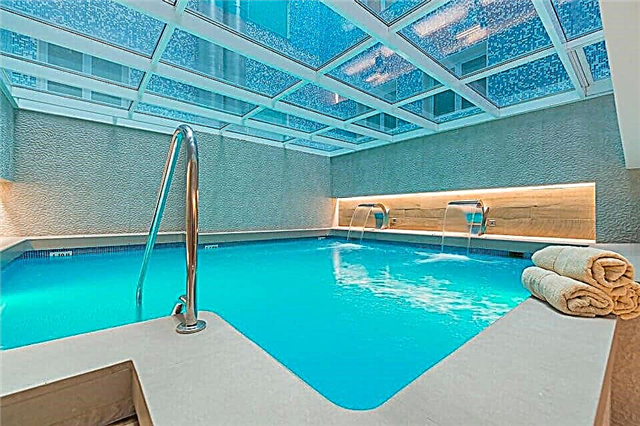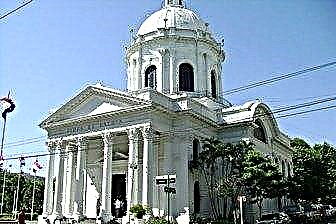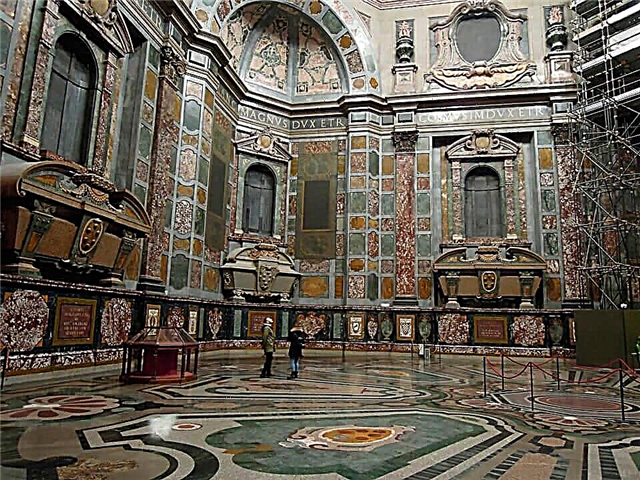The Medici Chapel in Florence is located on the grounds of the Church of San Lorenzo and is considered one of the most beautiful and sad places in the city. Thanks to the great masters of the Renaissance, the luxury of the earthly existence of the Medici clan was embodied in the decoration of their last refuge. Crypts and gravestones made by famous Renaissance masters remind of the corruption of earthly existence and the eternity of the universe.
Construction history
The Church of San Lorenzo, founded in 393 by Saint Ambrose, was reconstructed in the 11th century, after which it acquired the form of a rectangular basilica with columns of different sizes at the base. Architect Filippo Bruneleschi, commissioned by Cosimo the Elder de Medici, added a hemispherical dome-shaped structure to the medieval church in the 15th century and covered it with red tiles.
The long rectangular room of the Basilica of San Lorenzo ends with a bifurcation, on the left side of which is the old sacristy (sacristy) and the passage to the Laurenziano library building, on the right side there is the Medici Chapel, and at the end rises the Chapel of the Princes. The rough cladding on the outside of the church contrasts with its magnificent interior.
Interior decoration

The Church of San Lorenzo is the tomb of many prominent Florentine painters, historians and politicians. For the most famous personalities, sarcophagi have been installed on the marble floor and on the upper tiers of the walls. The basilica's pillars are crowned with gray stone Gothic vaults. In huge vertical niches canvases of the great Florentine painters Pietro Marchesini "Saint Matthew" 1723, "Crucifixion on the Cross" 1700 by Francesco Conti, "The Crucifixion and Two Sorrows" by Lorenzo Lippi are installed.
Part of the wall is decorated with a huge fresco depicting the Great Martyr St. Lawrence by the artist Bronzino, and a musical organ is installed on the dais. Through the bronze lattice, under the altar of the church, one can see the burial of Cosimo the Elder Medici, which was arranged by the townspeople themselves, expressing deep gratitude and gratitude to the patron of the arts and the ruler of Florence.
In the center of the hall, on high supports, there are two pulpits similar to sarcophagi. They are decorated with bronze reliefs depicting scenes from the life of Christ. These are the last works of Donatello - a unique master of bronze casting, the founder of the sculptural portrait and round statue, who spent the last years of his life in Florence and rests under a marble slab in the Church of San Lorenzo.
Timed admission ticket for Michelangelo's David - 16 €
Admission ticket to the Uffizi Gallery - 20 €
Uffizi Gallery: Priority Entrance € 40
Florence Cathedral: ticket with entry to the dome - 29 €
Entrance ticket and audio guide to Palazzo Vecchio - 19 €
Hop-on Hop-off tour. Ticket for 24, 48 or 72 hours - from 23 €
Leonardo da Vinci Museum: entrance ticket - 7 €
Tour to the Duomo with a guide and ascent to the top of the dome - 40 €
Entrance ticket to the Basilica of San Lorenzo - 8.50 €
Hot air balloon flight over Tuscany: Florence - 250 €
Old sacristy

The sacristy (sacristy) serves to store church supplies and prepare priests for worship, but in the Basilica of San Lorenzo it has a different purpose. The old sacristy turned into the crypt of the founder of the Medici family - Giovanni di Bicci. Designed by the architect Filippo Brunneleschi, the tomb is a perfect square space dominated by strict geometric lines.
Influenced by ancient masters, Brunneleschi uses columns and pilasters typical of Roman architecture in the interior. The walls are decorated with slabs of gray-green marble, which, in combination with beige plaster, emphasize the correct forms of the sacristy. A corridor under gloomy vaults leads to the lower burial chambers and the tomb of Medici Cosimo the Elder. The walls of the crypt are decorated with red altar velvet with patterns of silver ornate plates.
Bronze busts of the deceased Medici and precious church utensils are scattered everywhere. Particularly noteworthy are the silver cross for processions in 877, the reliquary of the Saints of the Dead in 1715, the gold tabernacle of Lorenzo Dolci in 1787. There is also the archbishop's shrine in 1622 and vessels with holy relics. The wooden doors of the crypt are skillfully carved.
New sacristy

The New Sacristy, or Chapel, was designed and recreated by the architect Michelangelo, commissioned by Pope Clement VII's Giulio Medici in 1520. The room was intended for the burials of the great Tuscan dukes of the Medici family. Michelangelo at that time was in a rather difficult position, being, on the one hand, a supporter of the Republicans, who fought a fierce struggle with the Medici, on the other hand, he was a court sculptor working for his enemies.
The master erected a temple and a crypt for the family, which, in case of victory, could severely punish its architect. The road to the Medici Chapel leads through the entire Basilica of San Lorenzo and turns right, where you can go down the stairs to the room with the tombs.
Sarcophagus of the Duke of Neymour
The muted colors of the room and the subtle rays of light shining through a small window in the ceiling create a feeling of sadness and peace in the ancestral tomb. In one of the niches on the wall there is a marble sculpture by Giuliano of the Duke of Neymour, the youngest son of Lorenzo Medici. The figure of a young man seated on a throne, dressed in the armor of a Roman soldier, and his head thoughtfully turned to the side. On either side of the sarcophagus lie majestic statues that represent Michelangelo's day and night.
Sarcophagus of the Duke of Urbino

On the opposite side of the wall, opposite Giuliano's coffin, is a sculpture of Lorenzo, Duke of Urbino's grandson of Lorenzo Medici. The Duke of Urbino Lorenzo is represented as an ancient Greek warrior sitting in armor over his tomb, and at his feet there are majestic sculptures that recreate morning and evening.
Sarcophagi of brothers Lorenzo the Magnificent and Giuliano
The third burial of the Capella is the grave of Lorenzo the Magnificent and his 25-year-old brother Giuliano, who died at the hands of the conspirators in 1478. The tombstone is made in the form of a long tabletop, on which there are marble statues "Madonna and Child" by Michelangelo, "Saint Cosma" by Angelo di Montorsoli and "Saint Domian" by Raphael di Montelupo. The entire composition of the Capella is united by the rapidly running moments of life and the endless flow of time.
Chapel of Princes

The entrance to the Chapel of Princes is possible from Madonna del Brandini Square, which is located on the opposite side of the Church of San Lorenzo. This luxurious room contains six burials of the hereditary Grand Dukes of Tuscany. The Hall of Princes was designed by Mateo Nigetti in 1604, and decorated by Florentine artisans from the Pietra dura workshop, which belonged to the Medici family.
Various types of marble and semi-precious stones were used for wall cladding. Thin stone plates were selected according to the ornament and were tightly fastened at the joints. The installed sarcophagi are decorated with the Medici family crests. The dukes were moneylenders and founders of the ramified banking system of Western Europe.
There are six balls on their coat of arms, which were considered the value of the interest rate on loans issued. The mosaic tiles at the bottom of the wall are represented by the coats of arms of the Tuscan cities. There are only two sculptures installed in the recesses - these are the Dukes Ferdinand I and Cosimo II. Due to the fact that the Chapel was not finally completed, other niches were left empty.
What else to see
The most valuable collection of books and ancient manuscripts is in the Laurenziano library. The library building and the magnificent gray staircase leading to it are the creation of Michelangelo's hands. The beginning of the collection of the manuscript collection was laid by Cosimo the Elder Medici and continued by Lorenzo I Medici, after whom the literary repository was named. To get to the library, you need to cross the well-kept churchyard.
Excursions

The reign of the Medici dukes lasted about 300 years and ended in the middle of the 18th century. The Medici skillfully used art and architecture to showcase their wealth and power. Court sculptors, architects and artists received orders for the construction of palaces and the production of paintings. At the beginning of the 15th century, several Medici families chose the Church of San Lorenzo as the burial place for members of their family.
Each of the branches of the dynasty paid for the construction and reconstruction of a specific site in the basilica. Someone from the clan was honored to be in the Chapel of Princes, and someone rests in the niches of the crypt. All the subtleties and interweaving in the biography of the most famous Tuscan family will be explained to travelers by competent guides who have extensive experience in conducting excursions around Florence and are fluent in historical material.
Mysteries of the Medici Chapel
The clan of the Medici dukes from the 15th to the 18th century created the history of Florence. Their family members included popes and two queens of France. The Medici were not only influential rulers, but also patrons of the arts who patronized the great creators of the Renaissance. Possessing enormous power and untold wealth, the Medici dukes, according to historical evidence, tried to buy at first, but when they were refused, they made several attempts to steal the Holy Sepulcher from Jerusalem in order to put it in the middle of the Chapel of Princes.
Who is buried in the Chapel of the Princes of the Basilica of San Lorenzo? What precious stones are used to decorate the octagonal tomb of the Dukes? Who owned and how were Florence's jewelry and granite workshops used? How did the mosaic surfaces of various rocks interconnect and why are no connecting seams visible on the wall cladding? Curious tourists will receive answers to these and many other questions using an individual excursion with a professional guide.
The great tombs of the Medici

Two years after the death of Pope Leo X, Lorenzo the Magnificent's grandson, Pope Clement XVII, continued to finance the construction of the chapel in the new sacristy of San Lorenzo. The sculptor Michelangelo and his apprentices have worked on the design of the Medici Chapel for over 10 years. Michelangelo's favorite material was white marble from the Carrara quarries. The master himself was often present at the selection of blocks for his works.
The allegorical sculptures of Day, Night, Morning and Evening in the Medici Chapel were also made by the architect from white Carrara marble and carefully polished to a shine. Explore all the corners of the Church of San Lorenzo and not get lost in the corridors of the tombs, learn a lot of interesting information in a short period of time and see the iconic sights of Florence and the Medici Chapel - this is possible only with the help of competent guides and individual excursions.
Medici and Renaissance

Freedom of creative choice was possible in the republican Florence, but starting from the 15th century, all talented craftsmen were completely dependent on the Medici court. Michelangelo was a supporter of the Republicans and opposed the tyranny of the Medici, while fulfilling the multiple orders of the family. Fearing the ducal wrath, the sculptor continued to decorate the Church of San Lorenzo, the Laurenziano library and the new sacristy.
After the defeat of the Republicans, Michelangelo hid from his masters in the sacristy under the chapel of San Lorenzo and stayed there until the Pope forgave his rebellion. After these events, in 1534, the master moved to Rome, without completing the design of the Medici Chapel. Work on the tomb of Lorenzo the Magnificent was continued by Vasari, and the sculptures of Cosimo and Domiano were made by the students of Michelangelo. The great Michelangelo (1475-1564) himself, a sculptor, poet, painter and engineer, is buried in the marble tomb of San Lorenzo.
The genius of sculpture by Donatello (1386-1466) played a special role in the design of the Basilica of San Lorenzo. Two huge lecterns, each standing on four columns, are decorated with bronze onlays made by a master. The plot for their design was biblical themes that describe the life of St. Lawrence, the Garden of Gethsemane and the Descent from the Cross. Being an unpretentious person, Donatello did not work for money, was content with modest food and did not wear rich clothes.
The money he earned was freely available to students, and according to the stories of his contemporaries, they were "kept in a basket suspended from the ceiling in the sculptor's workshop." Combining antiquity and Renaissance in his works, Donatello paid great attention to drawing and trial casts from wax and clay. Unfortunately, not a single scheme or sample has survived to this day.
These and other interesting facts about the role of the Medici in the centuries-old history of Renaissance Florence, tourists will learn from competent guides when conducting individual excursions.
Opening hours and ticket prices

The complex of historical buildings in the Church of San Lorenzo varies in terms of visiting time and requires a separate ticket purchase.
Opening hours of the Basilica of San Lorenzo:
- from 10.00 to 17.00 daily
- from 13.30 to 17.30 on Sunday
- closed on Sundays from November to February
Ticket offices close at 4.30 pm.
Ticket prices:
- 6 euros to visit the basilica;
- € 8.5 for a joint visit to the Laurenziano Basilica and Library.
Opening hours of the Medici Chapel:
- from 08.15 to 15.45;
- closed on January 1, December 25, May 1, from 1 to 3, and 5 Monday of the month, 2 and 4 Sunday of the month.
The cost of tickets to the Capella is 8 euros.
Where is it and how to get there
The Church of San Lorenzo and the Medici Chapel are located at Piazza di San Lorenzo, 9, 50123 Firenze FI, Italia.
City bus number 1 delivers tourists to the stop "San Lorenzo".
If you are driving your own car, you can use the underground car park of Florence Santa Maria Novella Train Station, which is within walking distance of the Basilica.











